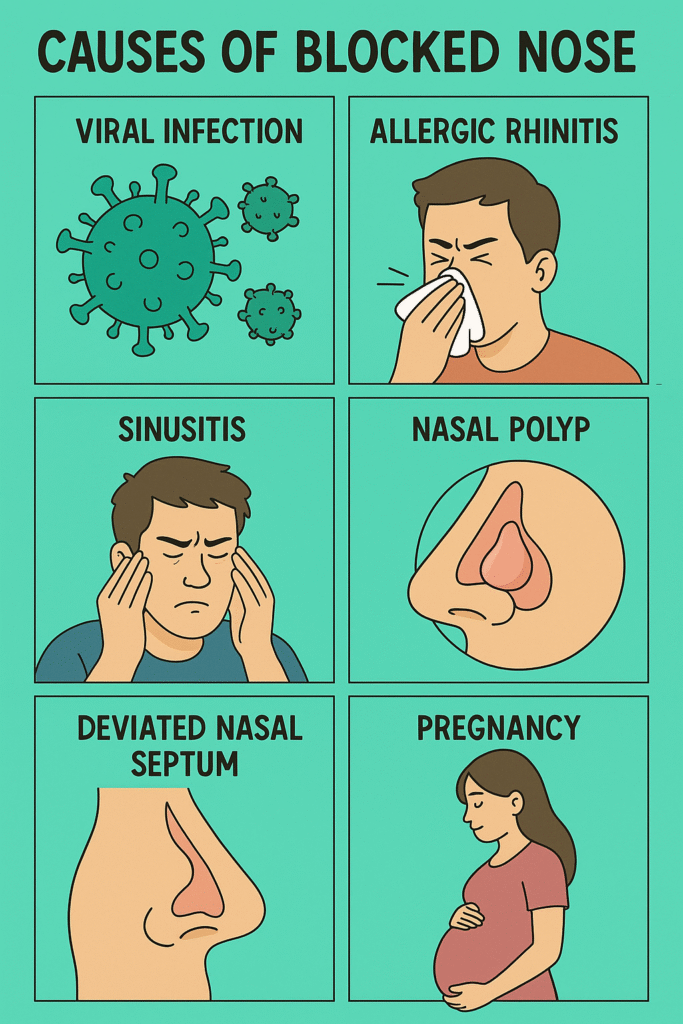Ever woken up with a stuffy nose that made breathing through your nose feel like trying to suck air through a clogged straw? You’re not alone. A blocked nose—often called nasal congestion—is one of the most common complaints people have when they’re sick or suffering from allergies. But what actually causes it? And what can you do to feel better?
Let’s explore this everyday annoyance in more detail—what it is, why it happens, and how to treat it effectively.
What Is a Blocked Nose?
A blocked nose is a condition where the nasal passages become swollen or filled with mucus, making it hard to breathe through your nose. It’s not always caused by too much mucus, though. In many cases, the swelling of the blood vessels in the sinuses is what gives that “stuffed-up” feeling.
Blocked noses are incredibly common. According to some estimates, over 30% of adults experience nasal congestion several times a year—especially during cold and flu season or allergy flare-ups.
How Does It Happen?
Think of your nose as a system of narrow tunnels. When you’re healthy, air flows smoothly through those tunnels. But if the inner linings become inflamed—due to infection, allergens, or irritants—those tunnels get narrower. This swelling restricts airflow and traps mucus, making it harder to breathe.
Here’s a helpful analogy: imagine squeezing a sponge under running water. The more swollen it gets, the less room there is for water (or air, in your nose) to pass through.
The body also produces extra mucus to flush out viruses or allergens, which adds to the blockage.
What Causes a Blocked Nose?
Blocked noses can be caused by a variety of things. Here’s a breakdown:
1. Viral Infections (like the common cold)
- Most common cause.
- Symptoms: runny nose, sneezing, fatigue, sore throat.
- Virus inflames the nasal lining and increases mucus production.
2. Allergies (Allergic Rhinitis)
- Caused by triggers like pollen, dust mites, pet dander.
- Around 10-30% of the global population suffers from allergic rhinitis.
- Histamines released during allergic reactions cause swelling and mucus.
3. Sinusitis
- Inflammation of the sinuses, often following a cold.
- Can be acute (short-term) or chronic (lasting over 12 weeks).
- Symptoms: facial pressure, headache, thick yellow or green nasal discharge.
4. Nasal Polyps
- Small, non-cancerous growths inside the nose.
- Can block airflow and often occur in people with asthma or chronic sinusitis.
- May require surgery if severe.
5. Deviated Nasal Septum
- A physical shift in the wall dividing the nasal passages.
- Can be present from birth or caused by injury.
- Causes one side of the nose to feel constantly blocked.
6. Environmental Irritants
- Smoke, pollution, perfumes, or chemicals can irritate the nasal lining.
- Can lead to temporary or chronic congestion.
7. Pregnancy
- Hormonal changes increase blood flow to the nose.
- Leads to swelling and congestion, especially in the third trimester.

Who Is at Risk?
Blocked noses don’t discriminate, but some people are more prone to them than others. Here’s who’s most likely to be affected:
- Children, especially those in daycare (frequent colds).
- People with allergies or asthma.
- Smokers and those exposed to second-hand smoke.
- People with structural nasal issues, like a deviated septum.
- Pregnant women due to hormonal changes.
- Those living in polluted or dry environments.
Other Symptoms to Watch For
A blocked nose rarely comes alone. Other common symptoms include:
- Runny nose (clear or thick discharge)
- Postnasal drip (mucus dripping down the throat)
- Sneezing
- Headache or facial pressure
- Snoring or mouth breathing, especially at night
- Loss of smell and taste
When congestion becomes severe or chronic, you might experience:
- Persistent fatigue (due to poor sleep)
- Sinus infections
- Difficulty concentrating
- Ear fullness or popping
Tests to Identify the Cause
The gold standard for figuring out why your nose is blocked depends on the suspected cause.
1. Allergies:
- Skin prick tests or blood tests (like IgE tests) can pinpoint allergens.
2. For Structural Issues:
- Nasal endoscopy (a thin camera goes inside the nose)
- CT scan of the sinuses may be done for chronic sinusitis or to detect polyps or septal deviation.
3. For Infection:
- Physical exam and history are usually enough.
- Cultures or imaging may be needed for persistent sinusitis.
How to Treat a Blocked Nose
Let’s talk solutions. The good news? Most cases are manageable with simple treatments.
Mainstream Treatments (Gold Standard)
- Nasal saline sprays or rinses: Clears out mucus and allergens. Safe for daily use.
- Nasal corticosteroid sprays (e.g., fluticasone): Reduces inflammation. Works well for allergies and sinusitis.
- Oral decongestants (e.g., pseudoephedrine): Shrinks blood vessels but should only be used short-term.
- Antihistamines: Effective for allergic causes. Non-drowsy options include loratadine or cetirizine.
Other Options
- Steam inhalation: Moistens nasal passages and loosens mucus.
- Warm compress over sinuses: Relieves facial pressure.
- Avoiding known allergens: Keep windows closed during pollen season, use air purifiers.
- Surgery: Needed in some cases of nasal polyps or a deviated septum.
⚠️ Note: Decongestant nasal sprays (like oxymetazoline) should not be used for more than 3 consecutive days, as they can cause rebound congestion.
Final Thoughts
A blocked nose might seem like a minor issue—until you’re dealing with it. Whether it’s from a cold, allergies, or something more structural, knowing the cause helps guide the right treatment.
If your congestion lasts more than 10 days, recurs frequently, or is affecting your daily life, don’t just power through it. See a healthcare provider for a proper diagnosis.
After all, breathing easily is something we often take for granted—until we can’t.
References
- Mayo Clinic – Nasal Congestion. https://www.mayoclinic.org/symptoms/nasal-congestion/basics/definition/sym-20050644
- Cleveland Clinic – What Causes a Stuffy Nose. https://my.clevelandclinic.org/health/symptoms/21160-stuffy-nose
- American Academy of Allergy, Asthma & Immunology – Allergic Rhinitis. https://www.aaaai.org/tools-for-the-public/conditions-library/allergies/allergic-rhinitis
- National Health Service (UK) – Blocked or Runny Nose. https://www.nhs.uk/conditions/blocked-or-runny-nose/
- Johns Hopkins Medicine – Nasal Obstruction. https://www.hopkinsmedicine.org/health/conditions-and-diseases/nasal-obstruction
